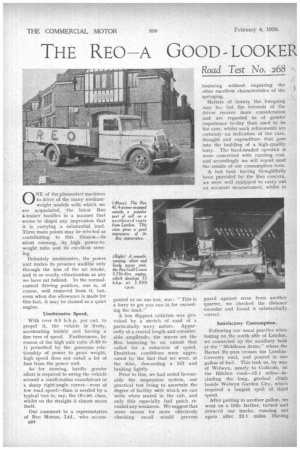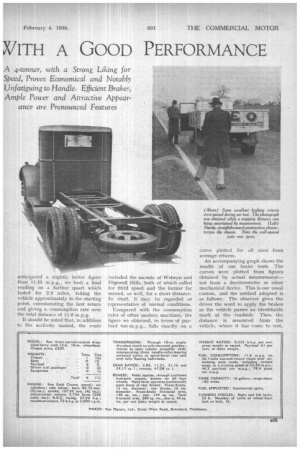THE EO A GOOD LOOKER VITH A• GOOD PERFORMANCE
Page 12

Page 13

Page 14

If you've noticed an error in this article please click here to report it so we can fix it.
ONE of the pleasantest machines to drive of the many mediumweight models with which we are acquainted, , the latest Reo 4-tonner handles in a manner that seems to dispel any impression that it is carrying a substantial load. Three main points may be selected as contributing to this illusion—its silent running, its high power-toweight ratio and its excellent steering.
Definitely unobtrusive, the power unit makes its presence audible only through the hiss of the air intake, and is as nearly vibrationless as any we have sat behind.. In the normalcontrol driving position, one is, of course, well removed from it, but, even when due allowance is made for this fact, it may be classed as a quiet engine.
Unobtrusive Speed.
With over 0.5 b.h.p. per cwt. to propel it, the vehicle is lively, accelerating briskly and having a fine turn of speed. Furthermore, by reason of the high axle ratio (5.83 to 1) permitted by the generous relationship of Dower to gross weight, high speed does not entail a lot of fuss from the power unit.
As for steering, hardly greater effort is required to swing the vehicle around a small-radius roundabout or a sharp right-angle corner—even at low road speed—than is needed by a typical vaii in, say, the 10-cwt. class, whilst on the straight it almost steers itself.
Our comment to a representative of Reo Motors, Ltd., who accomB24 panied us on our test, was : "This is a lorry to get you run in for exceeding the limit."
A less flippant criticism was provoked by a stretch of road of a particularly wavy nature. Apparently of a crucial length and considerable amplitude, the waves set the Reo bouncing -to an extent that called for a reduction of speed. Doubtless, conditions were aggravated by the fact that we were, at the fine, descending a hill and braking lightly.
Prior to this, we had noted favourably the suspension system, our practical test being to ascertain the degree of facility with which we can write when seated in the cab, and only this especially bad patch revealed any weakness. We suggest that some means for more effectively checking recoil Would prevent bouncing without impairing the other excellent characteristics of the springing. Matters of luxury the foregoing may be, but the interests of the driver receive more consideration and are regarded as of greater importance to-day than used to be the case, whilst such refinements are certainly an indication of the care, thought and expenditure that goes into the building of a high-quality lorry. The hard-headed operator is more concerned with running cost, and accordingly we will report next the results of our consumption tests.
A test tank having thoughtfully been provided by the Reo concern, we were well equipped to carry out an accurate measurement, whilst to guard against error from another quarter, we checked the distance recorder and found it substantially correct.
Satisfactory Consumption.
Following our usual practice when testing on the north Ode of London, we connected up the auxiliary tank at the "Middlesex Arms," where the Barnet By-pass crosses the LondonCoventry road, and poured in one gallon of fuel. This took us, by way of Welwyn, nearly to Codicote, on the Hitchin road-12.1 miles—including the long, gradual climb beside Welwyn Garden City, which required a longish spell of third speed.
After putting in another gallon, we went on a little farther, turned and retraced our tracks, running out again after 23.1 miles, Having anticipated a slightly better figure than 11.55 m.p.g., we took a final reading on a further quart which lasted for 2.9 ' •miles, taking the vehicle approximately to the starting point, corroborating the first return and giving a consumption rate over the total distance of 11.6 m.p.g.
It should be noted that, in addition to the acclivity named, the route included the ascents of Welwyn and Digswell Hills, both of which called for third speed and the former for second, as well, for a short distance. In short, it may be regarded as representative of normal conditions.
Compared with the consumption rates of other modern machines; the• figure we obtained, in terms of payload ton-m.p.g., falls exactly on a
curve plotted for all sizes from average returns.
An accompanying graph shows the results of our brake tests. The curves were plotted from figures obtained by actual measurement— not from a decelerometer or other mechanical device. This is our usual custom, and the method adopted is as follows: The observer gives the driver the word to apply the brakes as the vehicle passes anidentifiable mark at the roadside. Then the distance is measured from the vehicle, where it has come to rest, to the mark. This operation is performed from speeds of 10, 15, 20, 25 and 30 m.p.h.
We have explained this method because, on a recent occasion, a manufacturer experienced difficulty in reconciling certain figures obtained and published by us with figures of his own, .arrived at by the use of an instrument, the latter showing higher efficiency.
By The Commercial Motor system, any time lag that may exist is taken into consideration, which, in our opinio-n, is how it should be.
An efficiency of 60 per cent. was afforded by the foot brake, despite the fact that the roads were damp and slight skidding occurred. This figure is described by Ferodo, Ltd., as "very good."
Efficient Hydraulic Brakes.
It is of note that no power servo is employed to obtain this retardation; the Lockheed system, with, of course, a degree of self-energizing shoe action, is relied upon solely, and no great muscular effort is demanded. The system deserves full -marks, both on the ground of efficiency and the smoothness with which it brings the 6 tons 11 cwt. of laden lorry to rest.
Brockley Hill, near Elstree, was selected, as usual, for a hill-climbing test. By the long, steadily rising approach our speed was reduced to such an extent that second gear was engaged almost immediately upon reaching the foot of the final steep stretch. After changing, the speedometer showed 12 m.p.h., fell to 10 m.p.h. and then rose to 17 m.p.h. at the summit. The of 1 in Si. was covered in 55 seconds, which is not much in excess of the best time we have made up this hill with machines carrying only 3 tons.
Immediately after this fast ascent, we noted the temperature of the cooling water to be 160 degrees F., which was the figure that had been indicated by the dashboard instrument practically throughout the day. the test successfully, the brake holding it positively on the severe incline.
Then, using first gear, a start was made up the hill, and no difficulty experienced.
The transition from standing to moving was made without judder, as may occur with an overstressed Clutch, or a series of forward lurches, as is sometimes indicative of an excessively low gear, so one may conclude that the design represents an excellent compromise.
Gradients of greater severity than this are not normally tackled With full load, but we opine that the Reo, with standard axle ratio, would give a good account of itself under considerably more exacting conditions.
Quick acceleration, a high maximum and fair flexibility are shown by the accompanying acceleration graph. In spite of the high axle ratio, the vehicle picks up well from
10 m.p.h. too gear, whilst the quick and easy changes that are possible enable full advantage to be taken of the powerful and lively engine.
This unit, incidentally, has a stroke which is rather on the short side, and, as a result, its slogging qualities may be less pronounced than those of certain other comparable engines; but against this may be set its high speed, silence and smooth running. Preference for one or the other type is purely a matter of opinion, and the Reo unit is a fine example of its class.


































